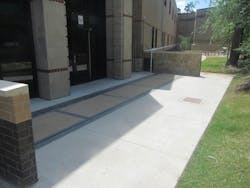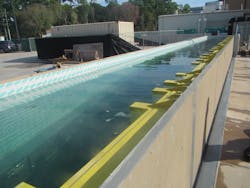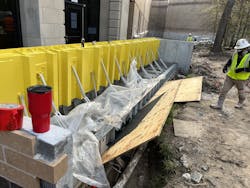Over the past decade, the United States has seen a significant uptick in the intensity of rain events, which have led to a considerable number of water-related disasters. Powerful hurricanes, melting snowpack and flash floods from extreme rain events have put buildings and the infrastructure under a steady barrage of water. In the United States, flooding has cost taxpayers more than $850 billion since 2000 — and $1 trillion since 1980 — and is responsible for two-thirds of the cost from all natural disasters, according to Flood Defenders, a non-profit organization whose goal is to make flood protection a top priority for elected officials. However, a meticulously designed and installed flood protection system can help prevent floodwaters from causing severe and long-term damage to a building and the surrounding infrastructure. To assess and design a proper flood protection system, the design team, along with the structure’s owner, must work together to ensure the system ensures adequate flood protection.
Proper education
Education is a critical aspect of any flood protection system. The first step involves a design team educating the property owner and any government entities that are involved in the project, including the Federal Emergency Management Agency (FEMA) if necessary. This educational opportunity allows peers to speak to each other in detail to understand the coordination, design, site/building limiting factors, implementation, and maintenance of a flood protection system. An effective flood protection system requires a complete understanding of the broad and localized watershed issues and associated risks that may impact a property. It also requires an understanding of the drainage constraints related to the property. This comprehensive education is necessary so that an informed decision can be made on what flood protection system is best for the structure.
Recently, Kingwood High School, located in Kingwood, Texas, suffered severe flood damage from three separate floods within two years. In each flood event, the school’s campus and gymnasium were destroyed, the latter of which required a total replacement each time. As a result, the Humble Independent School District (ISD), which includes Kingwood High School, required a comprehensive flood protection system to ensure protection against future flood events. A feasibility study was required to set the project parameters for Kingwood. The first task is to determine a flood protection elevation, which must meet both local and FEMA requirements. Next, the study identified the points of exposure to the facility, determined the optimum protection system that addressed all points of exposure, and offered flexibility to not impact daily activities. The study also worked through other issues including code requirements, agency interface requirements, anticipated costs, impact to operations and project schedule.
Several site walks at other structures were conducted in the Houston area with the Humble ISD, FEMA consultants and the design team. These walks ensured that the various components of the flood protection system being proposed for Kingwood could be visually demonstrated. Most importantly, the Kingwood High School leadership's attendance allowed the team to better educate them on different flood protection approaches with real life examples. The site walks provided Kingwood High School representatives the opportunity to hear first-hand information from the other owners about how the flood protection systems were applicable to their structures and to discuss any maintenance- related questions or concerns.
Design consensus
The importance of an integrated design solution is critical for any flood protection system to achieve consensus on the system design. The design of a flood protection system must be well thought out to address the various features that the design must incorporate, consideration of the various requirements for implementation, and specific details of what is required to keep the flood protection system operational and properly maintained. Additionally, if government funding is involved, flood protection can be designed and implemented with FEMA, meeting their requirements. In the case of Kingwood, several flood protection options were presented to the Humble ISD and their FEMA consultants after the onsite evaluation was completed by the design team. By recommending several flood protection options as well as the specific design details and cost options, the FEMA consultants concurred the designs allowed for normal day-to-day operation and aligned with FEMA flood protection requirements — several of which are now being incorporated on different FEMA projects. More importantly, after the initial designs were discussed, FEMA and Humble ISD settled on a flood protection system created by the design team that cost $14 million, a savings of millions of dollars from the initial design estimates which originally was $35 million.
From design to construction
Once the design has been approved and the project is under construction, the team requires regular site visits to verify the construction progress and quality of the work. At these visits, the team can make certain the protection is installed in accordance with the design plans. This verifies that the project will be in accordance with the contract documents when completed. For example, if one portion of the flood protection system is not correctly installed, flood waters may still breach the system, rendering the flood protection system moot. Due to topography around Kingwood High School, the existing buildings required eight feet of flood protection in the front and three-and-a-half feet in the back. The front of the building has float-up gates that connect to the external walls. Kingwood also required several different custom flood protection components tailored into the overall system to ensure the structure does not flood. For example, a flood protection wall was built in the vestibule, and flood walls were extended 75 feet beyond the building to include the vehicle laydown yard for the auto shop outside area. The auto shop on campus, which has float-up gates, required design of inlets and pumps to make certain the area does not flood.
“All the various types of flood protection measures required [were] based on the client’s needs and existing building conditions,” said Keith Gaynor, team director of civil engineering services at Walter P Moore. “The design team walked the perimeter of the building with the client to make sure we understood their needs. We then held design charettes in the office, producing multiple options for each flood vulnerability. This was then presented to the client providing the pros and cons of each. At the end of the day, the client knew what to expect and was extremely happy with how the design team kept them involved throughout the design process.”
Furthermore, per the Kingwood flood protection system, culverts were included on the campus’s exterior to divert stormwater from the athletic field and the cross-country running trails. During the design phase, the athletic director was consulted to ensure the system did not impact the use of the sports fields, requiring a few adjustments. In the final design, the fields were protected and improved based on the consultation’s feedback.
System maintenance
After the construction phase, a written protocol for how to operate the flood protection system must be developed with the owner’s staff to provide the necessary understanding and documentation for deployment of the system. The documentation serves as a guide to train future staff and is a critical reference before and during a storm event. The end of construction is the beginning of the flood protection system life. The owner’s staff should train and maintain the system on a semi-annual to quarterly basis. Documentation addressing system maintenance, testing and operations must be developed by the design team in consultation with the owner staff to establish future protocols and responsibilities. The design should also be easy to maintain for the owner. Typically, most flood protection systems are considered passive systems — meaning that, once installed, no effort is required to activate the flood protection. Kingwood High School required active components in addition to passive components. Maintenance is required for both approaches, and is critical to any flood protection system.









